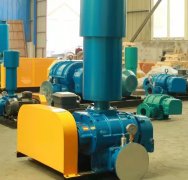Application and selection of Roots oxidation fan
Roots oxidation fan, as a type of positive displacement fan, achieves gas transportation through the rotation of the rotor and is widely used in multiple fields. The following is a detailed analysis of its application and selection:
1、 Application of Roots oxidation fan
1. Wastewater treatment: Roots oxidation fans play an important role in wastewater treatment, mainly used for aeration, stirring, and sludge dewatering. By injecting oxygen into the sewage, it promotes the growth and metabolism of microorganisms in the sewage, thereby degrading products and ammonia nitrogen. Meanwhile, during the sludge dewatering process, the Roots oxidation fan provides sufficient airflow to accelerate the sludge dewatering process.
2. Exhaust gas treatment: In exhaust gas treatment, Roots oxidation fans are used to emit and treat harmful gases. The exhaust gas treatment process requires a large amount of gas transportation and emission, and the Roots oxidation fan can provide stable airflow and tolerate gas composition, enabling the exhaust gas treatment system to operate stably.
3. In industries such as chemical, metallurgical, and building materials, Roots oxidation fans are also widely used. These industries have high requirements for gas transportation and ventilation, requiring stable and high flow airflow. Roots oxidation fan can meet these requirements and has the characteristics of energy saving, durability and reliability.
2、 Selection of Roots oxidation fan
1. Determine the conveying medium: Firstly, it is necessary to clarify the type of medium to be conveyed. For example, if air is being transported, ordinary materials can be selected; If transporting flammable or corrosive gases, fans made of cast iron or stainless steel should be selected.
2. Consider the working environment and application requirements: Determine the type and parameters of the fan based on the working environment (such as indoor or outdoor) and conveying requirements (positive pressure pneumatic conveying or negative pressure vacuum, etc.). For example, positive pressure pneumatic conveying typically requires higher air pressure and volume, while negative pressure vacuum may require lower air pressure.
3. Calculate air volume and pressure: Calculate the required air volume and pressure, as well as parameters such as motor power, based on the usage and operating conditions. Different types of applications have different requirements for fan parameters, so it is necessary to calculate and select according to the actual situation.
4. Other factors to consider: When selecting, factors such as dissolved oxygen content, tank volume, number of aeration heads, and aeration method should also be taken into account. These factors may affect the selection and performance of the fan, so they need to be considered comprehensively.
Specifically, the selection process can refer to the following steps:
1. Calculate and determine the ventilation volume of the site: The definition of fan airflow is the product of wind speed V and duct cross-sectional area F. For large fans, the calculation of air volume is relatively simple due to the ability to accurately measure the air volume with an anemometer. The air volume can be calculated directly using the formula Q=VF. Then, based on the selected room's air exchange rate, calculate the total air volume required for the factory building and the number of fans.
2. Calculate the total thrust required: It=△ P × At (N), where At is the cross-sectional area of the tunnel (m2) and △ P is the sum of various resistances (Pa).
3. Determine the overall plan for wind turbine layout: Based on the length of the tunnel, the required total thrust, and the range of thrust provided by the jet fan, preliminarily determine how many sets of wind turbines are arranged along the total length of the tunnel, how many units are in each set, and what is the thrust of each wind turbine to meet the total thrust requirements. Simultaneously consider the constraints of parallel and serial wind turbines.
4. Determine the parameters of a single fan: The performance of a jet fan is measured by the thrust it applies to the airflow. The thrust generated by the fan is theoretically equal to the momentum difference between the inlet and outlet airflow of the fan (momentum is equal to the product of the mass flow rate and flow velocity of the airflow). Under the testing conditions of the fan, the momentum of the inlet airflow is zero, so the theoretical thrust of the fan under the testing conditions can be calculated.
In addition, during the selection process, the following points should also be noted:
1. Choose energy-saving fans: Roots oxidation fans adopt technology and have energy-saving characteristics. By optimizing the design and motor, energy consumption can be reduced and work efficiency can be improved.
2. Choose a durable and reliable fan: The Roots oxidation fan adopts materials and advanced manufacturing processes, which have good durability and reliability, can operate stably for a long time, and reduce maintenance costs.
3. Choose low-noise fans: Roots oxidation fans use advanced noise reduction technology to reduce noise pollution and improve the comfort of the working environment.
In summary, Roots oxidation fans are widely used in multiple fields, and when selecting, multiple factors need to be comprehensively considered based on the actual situation to ensure that the fan can meet specific application requirements.



